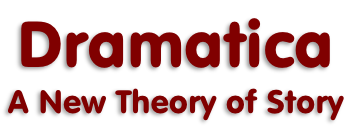|
For Story Structure |
|
For Story Development |
|
|

|
|

Free Online Book on Narrative Structure
Developed and Written by
Melanie Anne Phillips & Chris Huntley
Preface
Dramatica is a revolutionary theory of how and why stories work that can be used to analyze existing stories for flaws and to create original works with flawless structure.
This is a free online version of the original book that documented the theory, which became the basis for the Dramatica line of software products that implement the theory to help authors keep their stories structurally sound.
Originally introduced in 1994, both the theory and software have been used on countless best selling novels, motion pictures with collective box office receipts of billions of dollars, and in all media from short stories to stage plays to interactive fiction.
Beginning in 2010, the theory and software have been used extensively in real world applications of narrative, successfully predicting the behavior of terrorist groups, identifying the trigger points of lone wolf terrorists, and in the corporate world on projects ranging from establishing a group identity for a professional sports team to connecting a manufacturer of luxury cars with Millennial customers.
Here you will find a complete documentation of the nature, origin and function of narrative, both in fiction and the real world.
TABLE OF CONTENTS
In support of the on-
Dramatica: A New Theory Of Story
SECTION 1: THE ELEMENTS OF STRUCTURE
I. Dramatica & the Creative Writer
II. Foundations: Central Concepts
- The Story Mind
- The Four Throughlines
Characters
III. Introduction to Characters
- Hero is a Four Letter Word
- Objective and Subjective Characters
IV. Introduction to Archetypes
- The Eight Archetypes
- Complex Characters
V. Objective Character Functions
- Drivers and Passengers
- Examples from Star Wars, Wizard of Oz, and Jaws
VI. Action and Decision Elements of Drivers and Passengers
- Recap of Archetypal Characters
- Archetypal Actions and Decision Characteristics
- Archetypal Motivation Quads Examples from Star Wars, Wizard of Oz, and Jaws
VII. Placing Motivation Elements into Quads
- Grouping the 16 Motivation Elements
- Examples from Star Wars, Wizard of Oz and Jaws
VIII. Complex Motivation Characteristics
- Rules for Building Characters
- A Look at Complex Characters in Gone With The Wind and Rear Window
IX. Exploring Other Character Dimensions
- The 64 Character Elements Chart
- Mapping the Archetypal Pattern
- Examining Archetypal Methodologies
- Complex Character Dimensional Patterns
- Defining the Main and Obstacle Character
- The Main and Obstacle Character in the Objective Story
- The Main Character's Crucial Element
XI. Problem Solving and Justification
- What are Justifications?
- Whait is Problem Solving?
- Why we Justify
- A Simple Example of Problem Solving
- Defining the Problem
- The Justified Main Character
Theme
XII. Elements of Structure: Theme
- Describing the Story's Problem
- Chart of Dramatica Classes
- Domains
- Chart of Dramatica Types
- Concerns
- Chart of Dramatica Variations
- Ranges
- Chart of Dramatica Elements
- Problems
XIII. Domain Descriptions
- Matching Points of View to the Chart
- Objective Story Domain
- Main Character Domain
- Obstacle Character Domain
- Subjective Story Domain
XIV. Concerns, Ranges and Problems
- Domains and Beyond
- Concerns
- Ranges
- Problems
- The Thematic Argument
- Premise and the Thematic Argument
- Additional Appreciations
Plot
XVI. Elements of Structure: Plot
- Plot vs. Storyweaving
XVII. Plot Appreciations
- Goal
- Requirements
- Consequences
- Forewarnings
- Dividends
- Costs
- Prerequisites
- Preconditions
XVIII. Plot Progression
- Acts (Another View: 3 Act Progressions)
- Sequences (Three Act Progressions & Four Act Progressions)
- Scenes (What's in a Scene? & Characters in Scenes)
- Events (Events and Domains & Events Masquerading as Scenes)
Genre
XIX. Elements of Structure: Genre
- Modes of Expression
- Grid of Dramatica Genres
SECTION TWO: THE ART OF STORYTELLING
XX. SECTION TWO: The Art of Storytelling
- Foundations
- The Four Stages of Communication
Stage 1: Storyforming
XXI. Storytelling and Character Dynamics
- Resolve: Change or Steadfast?
- Direction: Stop or Start?
- Approach: Do-
er or Be- er? - Mental Sex: Male of Female?
XXII. Storytelling and Plot Dynamics
- Work: Action or Decision?
- Limit: Timelock or Optionlock?
- Outcome: Success or Failure?
- Judgemnt: Good or Bad?
XXIII. Storytelling and Storyforming Structural Appreciations
- Selecting the Domains in Your Story
- Picking the Proper Classes for the Domains in Your Story
XXIV. Storytelling and Plot Appreciations
- Static Plot Appreciations
- Progressive Plot Appreciations
- Acts
XXV. Storytelling and Thematic and Character Appreciations
- Change Characters and the Crucial Element
- Steadfast Characters and the Crucial Element
Stage 2: Storyencoding
XXVI. Introduction to Story Encoding
XXVII. Encoding Objective Characters
- Archetypal Characters
- Complex Characters
XXVIII. Encoding Subjective Characters
- The Main Character is not necessarily the Protagonist
- Encoding Mental Sex
XXIX. Encoding Theme
- Encoding the Objective Story Theme
- Encoding Theme for the Other Throughlines
XXX. Encoding Plot
- Encoding Progressive Plot Appreciations
- Signposts and Journeys
- Main Character Domain Plot Progression
- Obstacle Character Domain Plot Progression
- Subjective Story Domain Plot Progression
XXXI. Encoding Genre
- Medium & Format
Stage 3: Storyweaving
XXXII. Introduction to Storyweaving
XXXIII. Storyweaving and Structure
- Storyweaving Static Appreciations
- Storyweaving Characters
XXXIV. Storyweaving and Storytelling
Spatial Techniques
- Building Size
- Red Herring
- Meaning Reversal
- Message Reversals
Temporal Techniques
- Building Importance
- Non-
Causality - Out of Sequence Experiences
- Flashbacks and Flash-
forwards
XXXV. Storyweaving Tips
Tips for Short Stories
Tips for Episodic Television Series
- Characters in Episodic Series
- Plot in Episodic Series
- Theme in Episodic Series
- Genre in Episodic Series
Tips for Multi-
Tips for Novels
Tips for Motion Pictures
- The Rule of Threes
- Hand-
offs
Stage 4: Story Reception
XXXVI. About the Audience
- Writing for oneself
- The Author as Main Character
- Writing for Groups
XXXVII. A Quick Lesson In Propaganda
XXXVIII. Adaptation